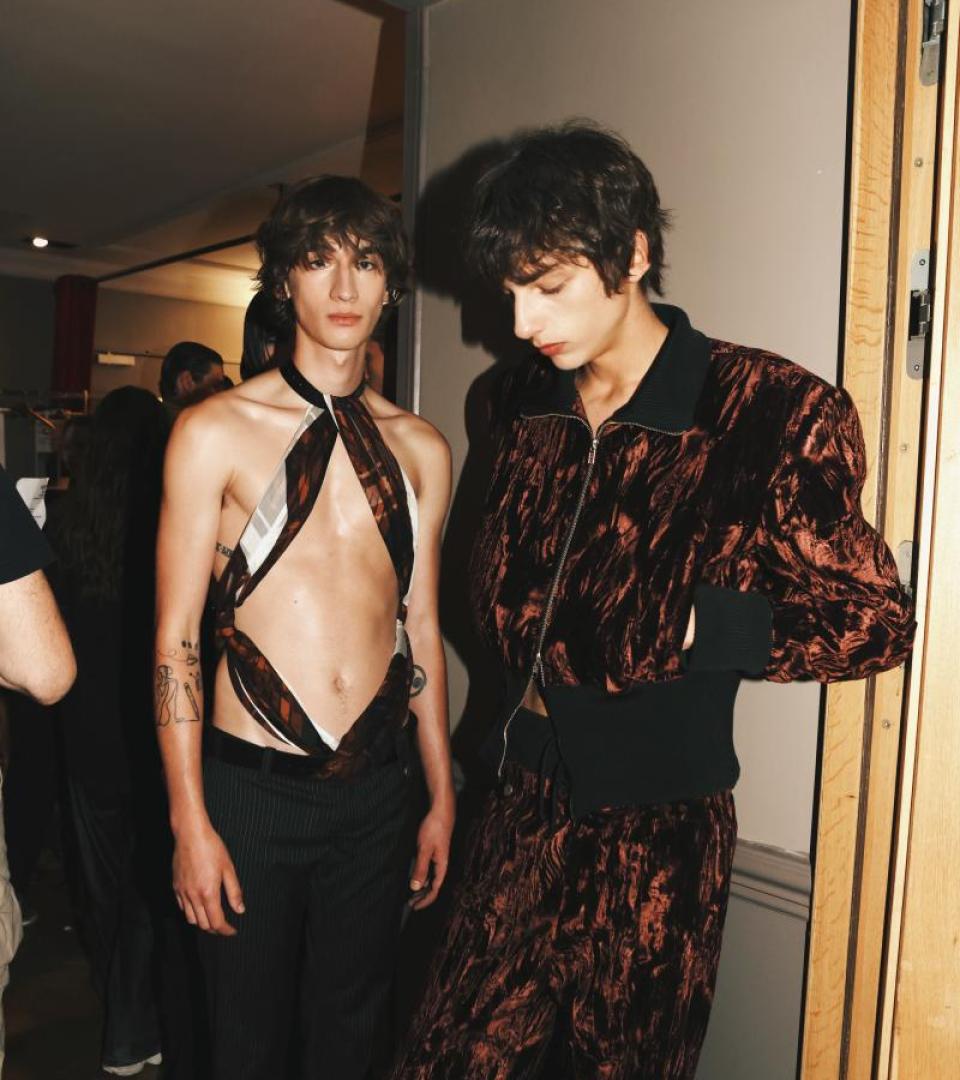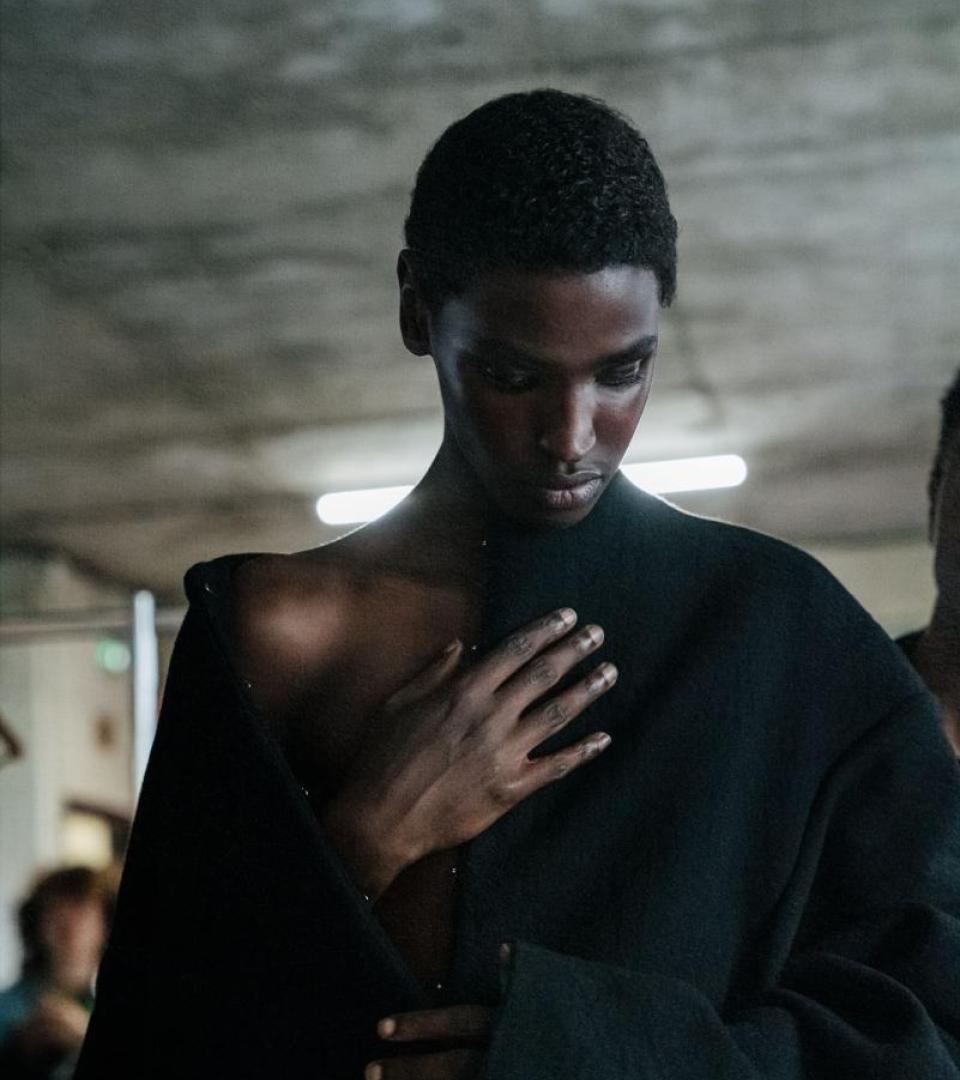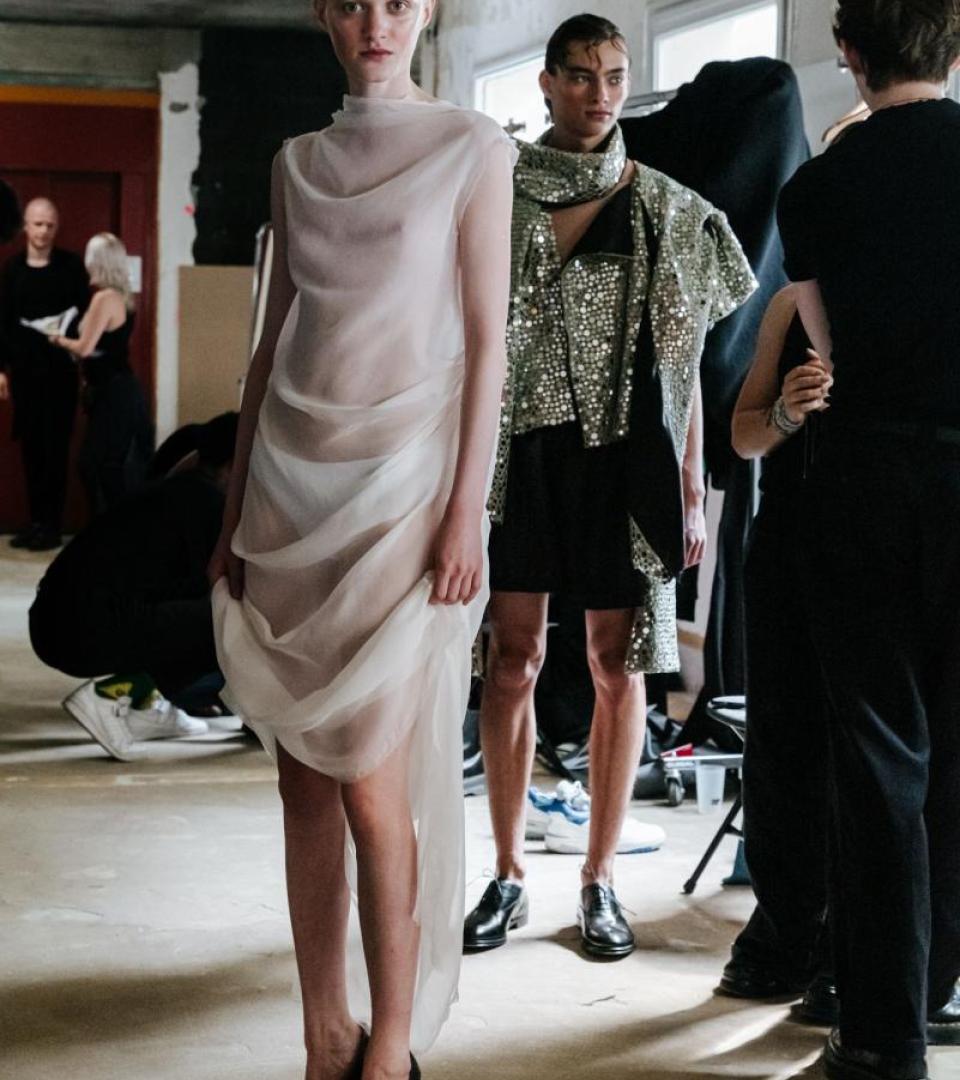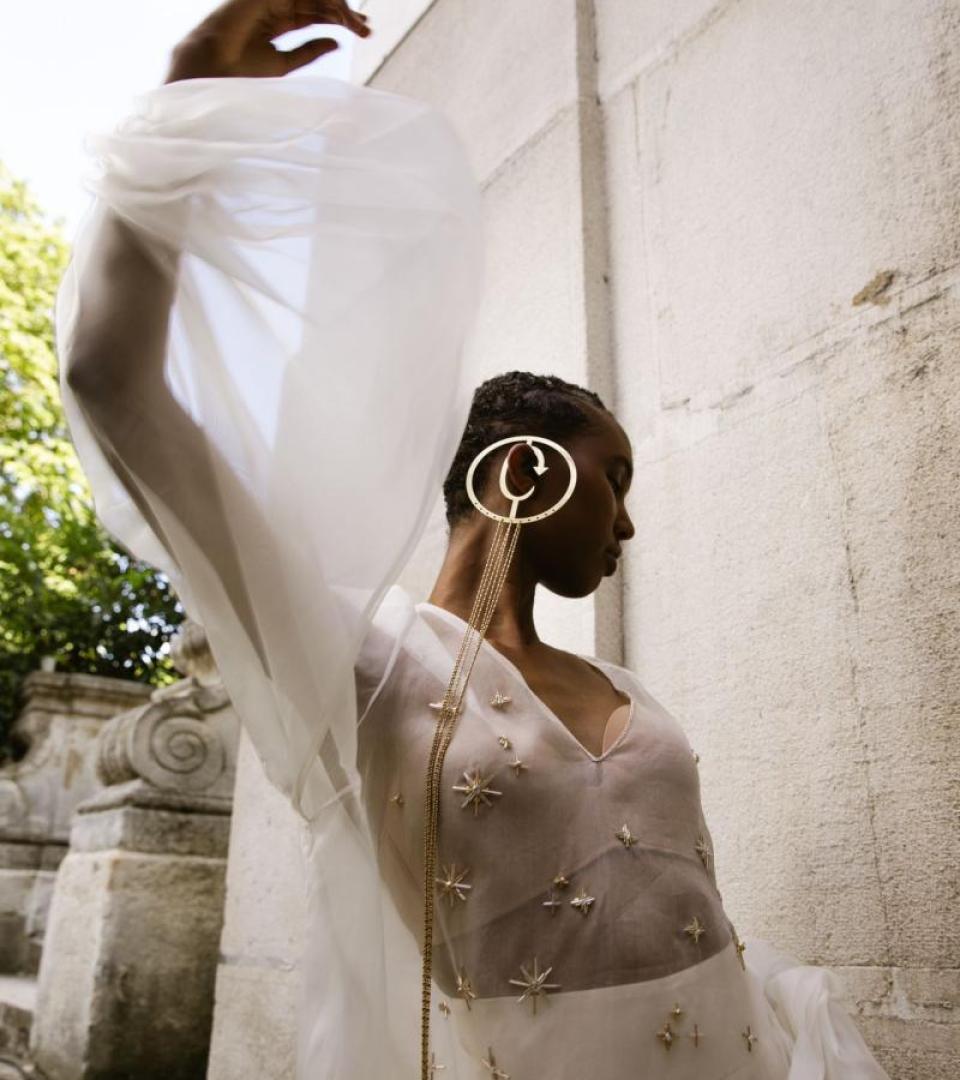Paris - Jukebox of masculinities
From 16 to 21 January, leading fashion houses and young designers presented their vision of the men's wardrobe for Autumn-Winter 2024-25 in Paris. From extravagance to simplicity, experimentation to the construction of basics, couture to functional pieces, the range was eclectic, sometimes hybrid, painting a masculine picture with multiple angles. By Manon Renault.
A neon lavallière collar shirt, a jacquard jumper worn with jogging trousers, and jeans with a trompe-l'œil double waistband: these twisty, heterogeneous basics meet and merge on the catwalk at Loewe, where artistic director Jonathan Anderson questions the impact of social media on visual culture, and by extension sartorial desire in the post-Instagram era of style supermarkets.
Inventive and deadpan, the collection explored the idea of collage head-on, multiplying 2-in-1 pieces like white socks fused with mauve tennis shoes. Here, the sense of humour and reflection shows the power of creation, and challenges the algorithm at a time when the fantasy of AI as a creative force floods the discourse. But AI is only a tool.
Anderson's fashion game raises a broader question: is it possible to sum up the masculinities presented in the Paris Fashion Week collections in an algorithm? Does the diversity of approaches, profiles and houses guarantee a much-needed shake-up?
The answer lies in the creations of Louis Gabriel Nouchi, Jeanne Friot, Burc Akyol and Adeju Thompson from Lagos Space Programme. The vision of a young scene with post-genre wardrobes, each in their own way offering reflections on innovation, upcycling, textile development and the promotion of Parisian and non-European crafts.
Rewriting patriarchal narratives
A suit with XXL shoulders and a muffled waist: since 2017, the silhouette designed by Louis Gabriel Nouchi has become an established part of menswear visual culture, and this season it is being extended to womenswear. “I'm developing my brand based on the feedback and needs of our community, and the womenswear line was increasingly sought after,” explains the designer, winner of the ANDAM 2023 Grand Prize, adding, “It was a challenge! We had to adapt the proportions of the trench coats and the tailoring without it becoming a gimmick.” As with his menswear shows, Nouchi built an inclusive cast, with plural silhouettes wrapped up in large shiny leather coats, midnight blue tailoring suits or tops made of jacquard in cut threads giving a furry look. On the runway, the pieces adapted for women are linked to those for men in a broader questioning of success and power, inspired by Guy de Maupassant's novel Bel-Ami (1855). A show collection fused with a literary encounter, Georges Duroy's social climbing can be seen in the gold tie clips, or the bracelets adorned with coins, giving the impression of having a pocketful of money. "It's a reflection on the status of men in society, and the notion of success and the power associated with it. In the 19th-century men's wardrobe, the suit was a rented item, as if to rent a social status. It was also a way of thinking about the place of women in success narratives," explains the designer whose collections can be read as queer re-readings that repair patriarchal narratives. Nouchi's formula of combining textile innovation with a questioning of past masculinity to write a queer narrative transposed into an affordable wardrobe has guaranteed the success of his highly acclaimed collection.
Absence of narratives
Last season, the designer Jeanne Friot also questioned the writing of the great classics, taking an interest in Andersen's The Little Mermaid, re-read with a genderfluid collection composed of wide denim skirts and basics such as bombers, which Friot keeps changing throughout the seasons. This season, the young designer, one of the few female names in the menswear calendar chose to combine intimacy and creation by talking about her love affair with Delphine. The collection focuses on the fusion of wardrobes in a couple's everyday life, with a rich mix of workwear, evening dresses, experimental pieces and basics. Between black and purple – a colour that symbolises lesbianism – the collection embodies the questioning that Friot has been pursuing since 2020: “Proposing a different vision of what men's fashion could be. While women have often been shown taking over men's wardrobes, it's time to do the same on the other side, so that everyone can be free to choose,” explained Friot.
This freedom of choice for men is also at the core of the work of queer Lagos-born designer Adeju Thompson. This season, his label, Lagos Space Programme, founded in 2018, aims to build bridges between British and Nigerian culture, reflecting on the tension between global homogenisation and local reception.
This gesture is part of the decolonisation of fashion advocated by the designer. Here, the garment is inspired by those worn in south-west Nigeria during the Ojude Oba festival, fused with British codes. "I imagined the story of a young British dandy who goes to the festival. There's tailoring but also lace and floral jacquards: it's both queer and decolonial". While Friot explores the merging of a couple's wardrobe, this is the fusion of a multi-cultural wardrobe. This hybrid approach is also the driving force behind the work of Jamaican-born Briton, Grace Wales Bonner, who presented a reinterpretation of the American preppy wardrobe at the Conservatoire national des arts, inspired by her time at Howard University, the first university to educate black Americans.
Human and cultural flows forge the richness of wardrobes, and in particular the myth of the Parisian wardrobe, as Burç Akyol reminds us. The Franco-Turkish designer, who hails from Dreux in France, recalls his teenage years here: “The visual culture of the 1990s was mixed, and that undoubtedly forged the creative approach of the new generation,” says Akyol, whose high-end eveningwear has been deconstructing orientalist stereotypes since 2019. This season, he is taking things a step further with a daytime and night-time wardrobe that ranges from jeans to red carpet dresses. For instance, he took a pink blouse from Demi Moore's wardrobe in Ghost, explaining, "For me, this American image is also about Parisian chic. For several decades the Parisian scene has been plural, and today that's also reflected in the fashion designers. There's a young generation coming through, which is exciting and shows that the face of Paris is multifaceted,” he concludes.
A variety of scenes serving menswear
Paris draws its wealth and attractiveness from the articulation of its fashion scenes. Pierre Bourdieu and Yvette Delsaut were already highlighting this feature in 1975 in their article " The couturier and his brand: a contribution to a theory of magic", investigating the rise of ready-to-wear in Paris and the reconfiguration of the scene.
Paris is constantly changing, as if in a palimpsest, with cumulative and articulated scenes. The experimental fashion of Rei Kawakubo with Comme des Garçons in the 1980s, followed by the Antwerp 6 with Walter Van Bereindonck and Dries Van Noten in the 1990s, persists. Each presented their own collection, as did the historic Parisian fashion houses that have gradually developed a menswear wardrobe over the last two decades. The androgynous Dior gentleman, designed by Hedi Slimane in 2000, becomes a dandy ballet dancer with Kim Jones in 2023, while the Louis Vuitton gentleman invented by Marc Jacobs in 1997 turns into a medium for exploring the American identity with Pharrell Williams, as the American presidential election looms.
It's impossible to sum up this rich scene in a single formula, or series of speeches. It's evolving with multiple social movements, brought together in one rich week.



